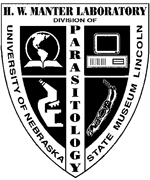Parasitology, Harold W. Manter Laboratory of

Harold W. Manter Laboratory of Parasitology: Library Materials
ORCID IDs
Escalante 0000-0002-1532-3430
Document Type
Article
Date of this Version
10-4-2022
Citation
Parasitology (2022) 150: 221–229
doi: 10.1017/S0031182022001421
Abstract
Morphological traits from blood stages have been the gold standard for determining haemosporidian parasite species. However, the status of some taxa and the value of such traits in parasites from reptiles remain contentious. The scarce sampling of these species worsens the situation, and several taxa lack molecular data. A survey was performed in the Magdalena Department in Colombia, where 16 species of reptiles were captured. A peculiar haemosporidian parasite was found in the Turnip-tailed gecko Thecadactylus rapicauda. This haemosporidian does not show malarial pigment in blood stages under light microscopy; thus, it fits the Garnia genus’s characters belonging to the Garniidae. However, the phylogenetic analyses using a partial sequence of cytochrome b and the mitochondrial DNA placed it within the Plasmodium clade. Our findings suggest that many putative Garnia species belong to the genus Plasmodium, like the one reported here. This study either shows that visible malarial pigment in blood stages is not a diagnostic trait of the genus Plasmodium or malarial pigment might be present in an undetectable form under a light microscope. In any case, the current taxonomy of haemosporidian parasites in reptiles requires revision. This study highlights the importance of using molecular and morphological traits to address taxonomic questions at the species and genus levels in haemosporidian parasites from reptiles.
Included in
Ecology and Evolutionary Biology Commons, Genetics and Genomics Commons, Parasitology Commons, Zoology Commons


Comments
Open access